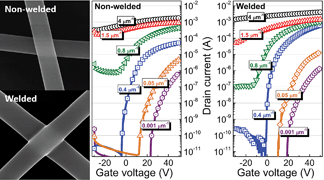High performance electronic devices based on nanofibers via a crosslinking welding process†
Abstract
Recently, metal oxide nanofibers fabricated by electrospinning have been considered as promising components for next-generation electronic devices. Unfortunately, the nanofiber-based electronic devices usually exhibited inferior electrical performance, due to the high contact resistance between the nanofibers and the inferior interfacial adhesion between the nanofibers and the substrate. In this report, an amine-hardened epoxy resin was selected as an adhesion agent to weld nanofiber junctions and improve the interfacial adhesion performance. It was confirmed that the physical properties of the nanofibers were greatly improved after the crosslinking welding process. Taking advantage of the welding process, field-effect transistors (FETs) based on In2O3 nanofiber networks (NFNs) with various nanofiber densities were integrated and investigated. It was found that the FETs based on In2O3 NFNs with a nanofiber density of 0.4 μm−1 exhibited the optimal electrical performance. When high-k ZrOx was integrated into the FETs as the dielectric layer, the FETs based on In2O3 NFNs/ZrOx exhibited superior performance, including a μFE of 13.2 cm2 V−1 s−1, an Ion/Ioff of 107, and an SS of 90 mV per decade. The crosslinking welding process is a simple, versatile and low-cost technique, which has great possibility for various applications.



 Please wait while we load your content...
Please wait while we load your content...